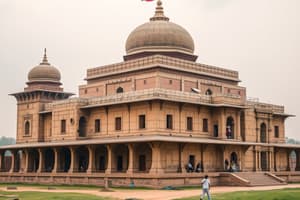Podcast
Questions and Answers
What was the primary source of revenue for the Mauryan Empire?
What was the primary source of revenue for the Mauryan Empire?
Land revenue and tributes
What was the significance of the Arthashastra in the ancient Indian economy?
What was the significance of the Arthashastra in the ancient Indian economy?
It was a treatise on statecraft and economics that provided guidance on governance and economic management.
What was the role of the guilds in ancient Indian economy?
What was the role of the guilds in ancient Indian economy?
They were associations of craftsmen and merchants that regulated trade and commerce.
What was the primary occupation of the people in the Indus Valley Civilization?
What was the primary occupation of the people in the Indus Valley Civilization?
What was the significance of the river systems in the development of early Indian states?
What was the significance of the river systems in the development of early Indian states?
Flashcards are hidden until you start studying
Study Notes
Here are the study notes for Theme 2: Kings, Farmers, and Towns (Early States and Economies, c. 600 BCE - 600 CE) of Class 12 History (NCERT book):
Rise of Early States
- Emergence of early states in 6th century BCE, marked by the rise of powerful kingdoms and empires
- Factors contributing to the rise of early states: growth of agriculture, expansion of trade, and development of new technologies
Emergence of Kings
- Kings emerged as rulers of early states, exercising control over people, land, and resources
- Kings claimed divine or sacred origins to legitimize their authority
Administrative Systems
- Early states developed administrative systems to manage and govern their territories
- Bureaucracy, taxation, and law and order systems were established to maintain control and stability
Economy and Agriculture
- Agriculture was the primary source of livelihood for most people, with crops like rice, wheat, and barley being cultivated
- Irrigation systems, such as dams and canals, were developed to support agriculture
- Trade and commerce grew, with the emergence of new technologies like the iron plow and coinage
Towns and Cities
- Early states saw the emergence of towns and cities, which served as centers of trade, commerce, and culture
- Cities like Pataliputra, Taxila, and Vaishali were important centers of learning, art, and architecture
Craftsmen and Merchants
- Craftsmen and merchants played a crucial role in the economy, producing goods and services, and facilitating trade and commerce
- Guilds were formed to organize and regulate the activities of craftsmen and merchants
Social Hierarchy
- Early states saw the emergence of a social hierarchy, with kings, nobles, and priests at the top
- The social hierarchy was based on occupation, wealth, and birth
Women and Family
- Women played a crucial role in the economy, particularly in agriculture and craft production
- The family was the basic unit of society, with the patriarch exercising authority over family members
Here are 20 test questions based on the theme:
- MCQ Questions*
-
When did the early states emerge in India? a) 6th century BCE b) 6th century CE c) 3rd century BCE d) 3rd century CE
-
Which of the following was a factor contributing to the rise of early states? a) Growth of agriculture b) Expansion of trade c) Development of new technologies d) All of the above
-
What was the primary source of livelihood for most people in early states? a) Agriculture b) Trade c) Commerce d) Industry
- Short Questions*
-
What was the significance of the emergence of kings in early states?
-
Describe the administrative systems established in early states.
-
What was the role of craftsmen and merchants in the economy of early states?
- Long Questions*
-
Discuss the factors contributing to the rise of early states in India. (Answer should be around 150-200 words)
-
Explain the significance of agriculture in the economy of early states. (Answer should be around 150-200 words)
-
Describe the social hierarchy that emerged in early states. (Answer should be around 150-200 words)
-
What was the role of women and family in the economy and society of early states? (Answer should be around 150-200 words)
-
Describe the emergence of towns and cities in early states. (Answer should be around 150-200 words)
- More MCQ Questions*
-
What was the purpose of the irrigation systems developed in early states? a) To support agriculture b) To facilitate trade c) To promote industry d) To build cities
-
Which of the following was a characteristic of the administrative systems of early states? a) Bureaucracy b) Taxation c) Law and order systems d) All of the above
-
What was the significance of the iron plow in the economy of early states? a) It increased agricultural productivity b) It facilitated trade c) It promoted industry d) It built cities
- More Short Questions*
-
What was the role of guilds in the economy of early states?
-
Describe the significance of coinage in the economy of early states.
-
What was the role of kings in the administrative systems of early states?
- More Long Questions*
-
Discuss the significance of trade and commerce in the economy of early states. (Answer should be around 150-200 words)
-
Explain the role of the social hierarchy in the society of early states. (Answer should be around 150-200 words)
-
Describe the cultural and intellectual achievements of early states. (Answer should be around 150-200 words)
Note: These questions are meant to be a sample and can be modified or expanded as per the requirements of the student or teacher.
Studying That Suits You
Use AI to generate personalized quizzes and flashcards to suit your learning preferences.





